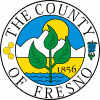Fresno County (Fresno County)
 |
Fresno County comprises the Fresno, CA Metropolitan Statistical Area, which is part of the Fresno-Madera, CA Combined Statistical Area. It is located in the Central Valley, south of Stockton and north of Bakersfield. Since 2010, statewide droughts in California have further strained both Fresno County's and the entire Central Valley's water security.
The area now known as Fresno County was the traditional homeland of Yokuts and Mono peoples, and was later settled by Spaniards during a search for suitable mission sites. In 1846, this area became part of the United States as a result of the Mexican War.
Fresno County was formed in 1856 from parts of Mariposa, Merced and Tulare counties. Fresno is Spanish for "ash tree" and it was in recognition of the abundance of the shrubby local Ash, Fraxinus dipetala, growing along the San Joaquin River that it received its name. Parts of Fresno County's territory were given to Mono County in 1861 and to Madera County in 1893. The original county seat was along the San Joaquin River in Millerton, but was moved to the rapidly growing town of Fresno on the newly built Southern Pacific Railroad line after a flood destroyed much of the town.
The settling of Fresno County was not without its conflicts, land disputes, and other natural disasters. Floods caused immeasurable damage elsewhere and fires also plagued the settlers of Fresno County. In 1882, the greatest of the early day fires wiped out an entire block of the city of Fresno, and was followed by another devastating blaze in 1883.
At the same time residents brought irrigation, electricity, and extensive agriculture to the area. In 1865, William Helm brought his sheep to Fresno county, which was then a vast space of open land. Helm was the largest individual sheep grower in Fresno County. Moses Church developed the first canals, called "Church Ditches," for irrigation. These canals allowed extensive cultivation of wheat. Francis Eisen, leader of the wine industry in Fresno County, also began the raisin industry in 1875, when he accidentally let some of his grapes dry on the vine. Anthony Easterby and Clovis Cole developed extensive grain and cattle ranches. These and other citizens laid the groundwork for the cultivation of Fresno County – now one of the nation's leading agricultural regions. In more recent times cotton became a major crop in Fresno and the southern San Joaquin Valley, but recent drought and lower demand have lessened cotton's importance to the local economy.
The discovery of oil in the western part of the county, near the town of Coalinga at the foot of the Coast Ranges, brought about an economic boom in the 1900s (decade), even though the field itself was known at least as early as the 1860s. By 1910, Coalinga Oil Field, the largest field in Fresno County, was the most richly productive oil field in California; a dramatic oil gusher in 1909, the biggest in California up until that time, was an event of sufficient excitement to cause the Los Angeles Stock Exchange to close for a day so that its members could come by train to view it. The Coalinga field continues to produce oil, and is currently the eighth-largest field in the state.
More than thirty structures in Fresno County are on the National Register of Historic Places, including the Fresno Water Tower, which once held over 250,000 USgal of water for the city of Fresno, the Meux Home, and Kearney Mansion Museum.
Map - Fresno County (Fresno County)
Map
Country - United_States
 |
 |
| Flag of the United States | |
Indigenous peoples have inhabited the Americas for thousands of years. Beginning in 1607, British colonization led to the establishment of the Thirteen Colonies in what is now the Eastern United States. They quarreled with the British Crown over taxation and political representation, leading to the American Revolution and proceeding Revolutionary War. The United States declared independence on July 4, 1776, becoming the first nation-state founded on Enlightenment principles of unalienable natural rights, consent of the governed, and liberal democracy. The country began expanding across North America, spanning the continent by 1848. Sectional division surrounding slavery in the Southern United States led to the secession of the Confederate States of America, which fought the remaining states of the Union during the American Civil War (1861–1865). With the Union's victory and preservation, slavery was abolished nationally by the Thirteenth Amendment.
Currency / Language
| ISO | Currency | Symbol | Significant figures |
|---|---|---|---|
| USD | United States dollar | $ | 2 |
| ISO | Language |
|---|---|
| EN | English language |
| FR | French language |
| ES | Spanish language |

















